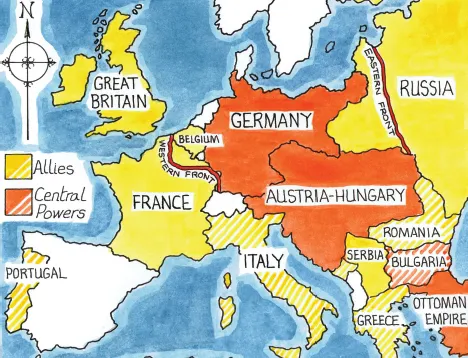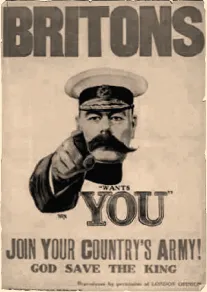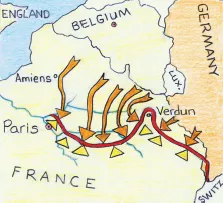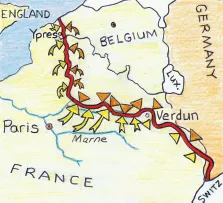![]()
Chapter 1
Opening Moves
Battle Lines are Drawn
The British Army in August 1914 consisted of a volunteer force of some 400,000 officers and men. It was well trained and equipped, with around half its number devoted to maintaining stability around the British Empire. Just as important was the Royal Navy, defending and linking the colonies together and ensuring that trade could flourish and carry forward the benefits of the new science and technology which the Victorian era had created.
The last thing wanted was a European war. These were surely episodes of past history, and Britain now had a global theatre to be concerned with. So it was ironic that the First World War began with the assassination of an Archduke in Sarajevo, Serbia, in circumstances of pantomime proportions in July 1914. For details, see Appendix 1 The Origins of the First World War, on page 84.
Europe with the Allies marked in yellow and the Central Powers in orange. The shaded countries joined the respective coloured sides after 1914, those in white remained neutral. Germany had the problem of two fronts on land to deal with. Its access to the Atlantic was blocked by Britain, which made it vulnerable to having supply ships blockaded by the Allies.
Unfortunately, Franz Ferdinand was the heir to the Austro–Hungarian Empire, which had links and treaties with European nations that could and did drag all of them into conflict.
Austria-Hungary used the assassination of Archduke Ferdinand as an opportunity to stamp its authority upon the Serbians. The Austro-Hungarian government accused the Serbian government of being behind the plot and on the 23rd July 1914, they delivered an ultimatum demanding access into Serbia to carry out a judicial review. The Serbians proposed arbitration and upon hearing this, the German Kaiser wrote, ‘A great moral victory for Vienna; but every pretext for war falls to the ground.’ But Austria-Hungary had no intention of waiting and on 28th July they declared war on Serbia. Within two days their artillery was firing at the Serbian capital of Belgrade. The Russians, bound by treaty to Serbia, had already begun to mobilise, despite a warning from Germany that they would counter any efforts they made to support Serbia. The Kaiser was now convinced that the Triple Entente nations (Britain, France and Russia) were manipulating events in order to draw Germany into war. On the 2nd August, Germany, allied to Austria-Hungary by treaty, declared war on Russia and then invaded neutral Belgium, declaring war on France at the same time. Britain initially emphasised that her Entente Cordiale with France was only an understanding, but fearful that a victorious Germany would be calamitous for British interests, they used an 1839 treaty protecting Belgian neutrality as a pretext to declare war on Germany two days later.
Kitchener’s call for volunteers: unlike many at the time, he thought the war could last for years rather than months, and fronted a massive recruitment campaign to build up a suitably large army.
All sides assumed, like previous wars, that ‘it would be over by Christmas’ and prepared themselves for fast moving, mobile warfare.
The Schlieffen Plan
The German army had over 700,000 troops. As there was universal conscription for young men in the country, they could call up a further three million reservists within a week of the beginning of the war. They also had a plan, devised by Count Alfred von Schlieffen, their Chief of Staff up until 1906, which tried to solve their problem of an enemy on both their East and West Fronts. Von Schlieffen presumed that the Russians would be slow to mobilise and that the French would try and claim back their former lands in Lorraine and Alsace first. He advised that the German army should therefore pass through Holland and Belgium and then swing round the back of Paris, capturing the capital and trapping the French army in one vast pincer movement. They could then send their forces to the Eastern Front to deal with the later threat from Russia. However, the new Chief of Staff, Helmuth von Moltke, amended the plan by taking a more challenging route directly into Belgium. The result was that the Germans were held up for nearly two weeks trying to take stoutly defended forts and did not enter Brussels until 14th August.
This delay gave the French additional time to prepare their army. It was of a similar size to the Germans’, containing experienced soldiers from North African conflicts with a special skill for dash in attack. The French ‘Plan 17’ concentrated their forces upon an attack into Lorraine and Alsace, as von Schlieffen had predicted, and they assumed that the Germans would not invade via Belgium. On 14th August, their forces rolled across the border but were forced back by German heavy artillery and machine guns, suffering around 300,000 casualties in just two weeks of fighting.
To the north, the British Expeditionary Army of just over 100,000 men had landed and clashed with the German forces at Mons, Belgium on 23rd August. Despite inflicting heavy casualties due to their excellent rifle skills, the British were heavily outnumbered and began to fall back and meet up with the retreating French forces. However, the German plan was already in trouble. Its huge sweeping movement designed to capture Paris was falling short and they were having problems getting sufficient supplies to the front line. In addition, the Russians surprised them with the speed of their mobilisation by launching an offensive on the Germans’ Eastern Front, which then obliged them to take resources away from the west in order to force the Russians back.
Late August 1914
Early September 1914
Mid November 1914
The Western Front Becomes Entrenched
The French quickly reassembled an army and, along with the British forces, pushed the Germans back from the east of Paris in what came to be referred to as the Miracle of the Marne. The German forces retreated to the next defendable line, the river Aisne, where they were able to select high ground and dig themselves in, creating a formidable barrier which held the allied forces at bay. Unable to breach this line they too had to build trenches to keep their men out of the firing line of enemy artillery and gun fire. This left a large gap to the north and both armies tried to go round the side of each other (outflanking) in the Race to the Sea. This was a series of offensives which continued into November 1914 when the coast was reached. As winter was closing in and both sides were exhausted, the Allied and German forces dug lines of trenches to hold their positions and so formed a vast barrier which stretched from the Belgian coast down to the border with Switzerland in the south, a distance of around 400 miles. The more defensive-minded Germans had taken vast swathes of Belgium and northern France and here they built more permanent defences. The Allies, who saw this as just a temporary halt to proceedings, dug less substantial trench systems, confident that in the following spring offensive they would be marching on towards Berlin. Few who constructed, lived and fought minor skirmishes and raids through that first winter envisaged that the grim, muddy hell hole which they had created was to be their home for much of the next three and a half years.
These three maps show the movement of the armies and position of the Western Front (marked in red) during the turbulent fighting of late summer and autumn 1914.
The final map shows the Race to the Sea as both sides tried to outflank each other, together with what was to be the approximate position of the Front for the following three years.
‘I adore war. It is like a big picnic but without the objectivelessness of a picnic. I have never been more well or more happy.’
Captain Julian Grenfell,
October 1914
Julian Grenfell wrote enthusiastically about going to war and this quote triggered arguments in the press about the way it encouraged men to sign up under a false understanding of what they would face at the front.
This talented poet died in May 1915 when a shell fragment hit his head. His brother was killed two months later only a mile from where Julian had been struck down.
Princess Mary’s Gift Box
Christmas, 1914
This small brass box with a beautifully embossed lid contained tobacco or sweets and chocolate for everyone serving in uniform on Christmas Day, 1914. It also came with a greetings card from the Princess that looked forward to a ...






